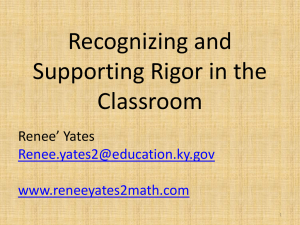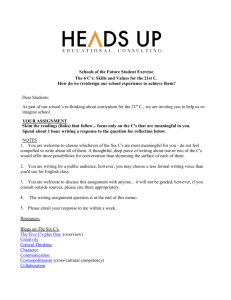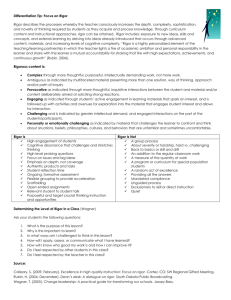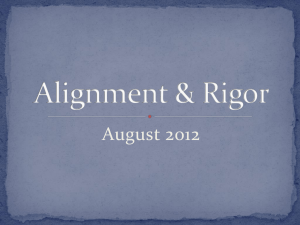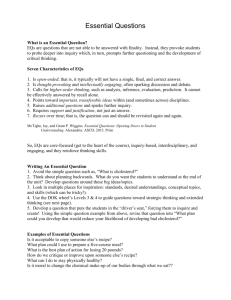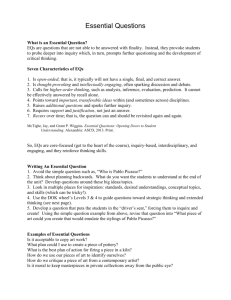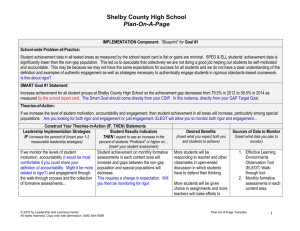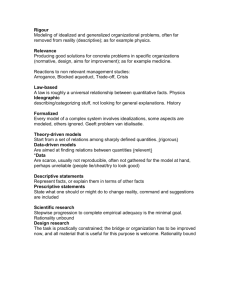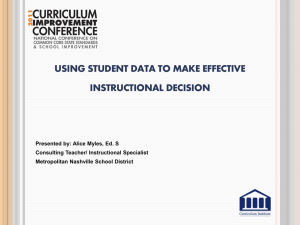KAAC Presentation October 23, 2012
advertisement
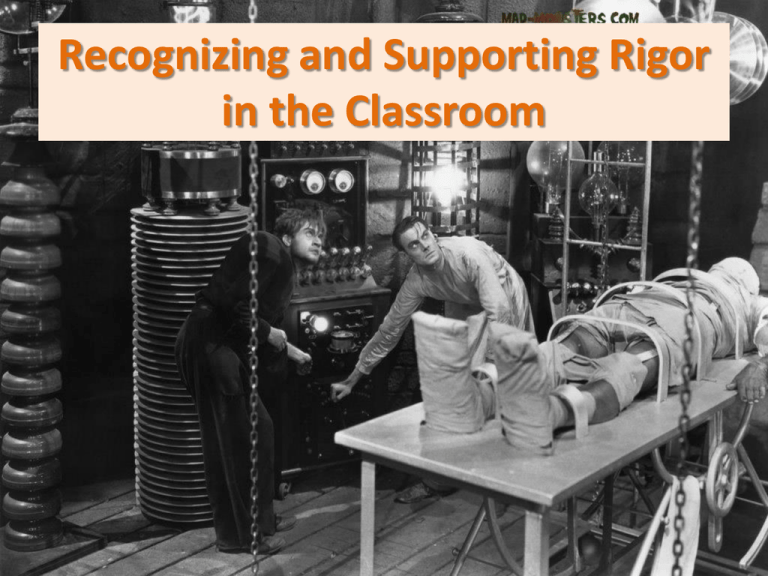
Recognizing and Supporting Rigor in the Classroom What is Rigor? Chocolate A preparation of the seeds of cacao, roasted, husked, and ground, often sweetened and flavored, as with vanilla. Rigor Strictness, severity, or harshness, as in dealing with people Experience – Ask yourself • What did it look, feel, sound like? • What was I doing? • What did others do (if anything) to create that experience for me? Have you ever had this conversation? A visit to a mathematics classroom: What do you see when you go into the mathematics classrooms in your building or district? What (and whom) do you hear when you go into the mathematics classrooms in your building or district? A Common Definition Of “Rigor” Rigor is not • • • • Harder Failing students More work Student responsibility (their fault if they don’t get it, they should work harder!) Rigor is • Cognitively demanding • Opportunities for deeper connections • Application of skills, processes • Student responsibility (they have understanding of where they are in relation to target and know how to get help to get there) What Research Says About Rigor (TIMMS Video Study, 1993) • Most of time in US math classes is spent practicing mathematical procedures and reteaching • The key feature of success is that students engage in active struggle with mathematics concepts and procedures. CHETL Section 3 Framework for Teaching • Domain 1 – Planning and Preparation –1C Setting Instructional Outcomes They require students to apply what theyto know Questions askabout aboutMoving the classroom: around the mathematics classroom asking • Who is doing of question the talking? Usually with most another questions and taking such “What the haveproblems? you already notes about the • Who is as, working tried?” “What do you already strategies, • What kinds of questions conversations, are being asked? know that can help you?” “Does etc. s/he observes. • What are the like? Higher order it matter thatproblems …?” It depends! • What happens when a questions student getsthat stuck? Always the students!!! Theyistalk a partner to try to • Where thewith teacher during practice? require higher figure it out. teacher may askwhen a • How does s/heThe answer students they leveloutcognitive question to help them figure what ask a question? they already know that can help them. engagement. They try out different ideas. Let’s Observe! Let’s observe another class. My brain hurts! Write a new scenario! Tortoise Divine Sacred Wise Long-lived Slow Tired Silly Tough Teacher How do you support the change? • Shift focus to student actions/responses. • Isolation must be removed. Direct, inclassroom support works best for initiating, honing, and adapting new instructional strategies. • Training must be done with teachers rather than to teachers, and this takes a team. Change Paradigms Everybody on the bus! A few key people in the car! The Leader’s Job 1. Who gets in the car? 2. In what order? 3. To what destination? Good news: Others can drive as well, but the leader has to know the destination and provide clear directions. So, who gets in the car first? • Initiators (3-10%) • Earlier Adopters (15%) • Later Adopters (60-82%) • Resisters (15%) Teachers working together with their leader not only have support to change but also gain a high level of commitment to execute change. Collegiality is a break from the isolation of teachers working and learning on their own. Collegiality is a professional interaction among teachers and leaders with the purpose of learning from each other to develop expertise together. What’s happening in the car? • Planning lessons/assessments collaboratively. • Watching and discussing each others’ classroom lessons. • Learning about the content standards and standards for practice together. • Planning and trying out strategies, questions, etc. and discussing the results. • Developing, using, and refining instruments to assess their own teaching and their students’ learning. • Analyzing data. (not just state assessment data!) What does this mean for you? • You must be in classrooms. You can’t lead classroom change if you never see, know, or take part in what is going on there! • You need a leadership team. • Team means learning together and shared leadership. AND… • Focus on student action and learning that results from teacher action. Where is everybody? Initiators Early Adopters Late Adopters Resisters What do we do with the resistors? Rational Emotional The Rider Weaknesses Strengths • Can easily be overpowered • by the elephant • • Tends to overanalyze or • overthink things Ability to think long-term Ability to plan Ability to think beyond the moment The Elephant Weaknesses • Lazy and skittish • Looking for a quick payoff Strengths • Fierce emotion/dedication • Energy to get things done So, if you want to change behavior: • Direct the rider. What looks like resistance is often a lack of clarity. So provide crystal clear directions. • Motivate the Elephant. What looks like laziness is often exhaustion. The rider can’t get his way by force for very long. Engage people’s emotional side. • Shape the Path. What looks like a people problem is often a situation problem. Many educators work within the framework of what is expected. It is safe and it is what people are used to doing. Unfortunately, this is not where needed change in education will come from. A new conception of teaching and learning cannot be developed within this framework. The teaching gap will persist. The bridge to improving teaching methods will crack. Closing the Teaching Gap Donald B. Bartalo, 2012 Contact Us • Teresa Emmert, NBCT Kentucky Department of Education Teresa.emmert@education.ky.gov www.Teresaemmert.weebly.com • Renee’ Yates, NBCT Kentucky Department of Education Renee.yates2@education.ky.gov www.reneeyates2math.com
